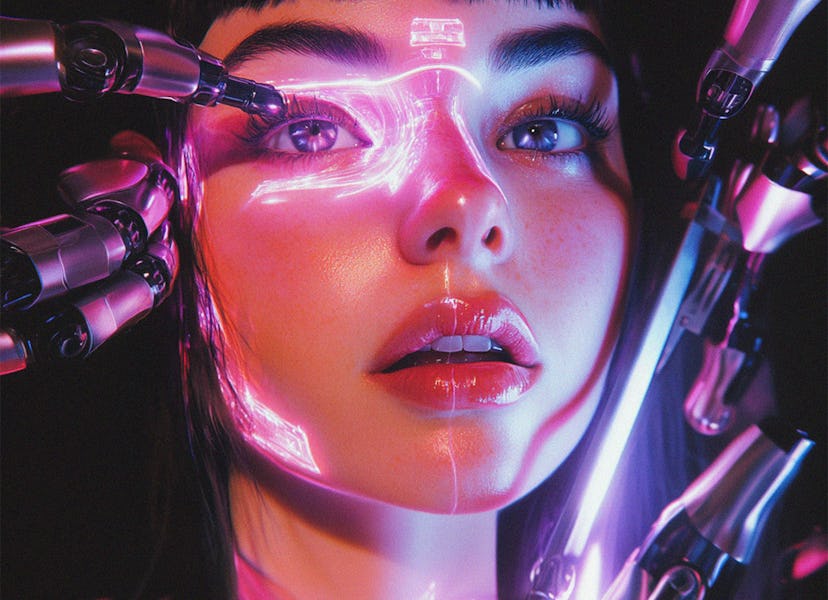
The New Robotics
My Robot Nail Technician & Me
Are AI beauty treatments the key to the future?
On a recent Thursday afternoon, I roll up to a quiet office park in Beverly Hills where I’m scheduled to receive a manicure from a robot. I make my way through the outdoor lobby, past people in suits working on laptops and the Goop kitchen selling kombucha and macrobiotic bowls, to a door that reads “Zo Lounge.” Behind it, my robot waits, stationed in a corner of an empty room, looking like an oversized Keurig coffee maker and promising the “guilt-free indulgence” of a 10-minute “minicure.”
The robot is called Clockwork and is one of a fleet of “minicure” robots available for lease à la vending machines or ATMs. (There are Clockworks at several airports across the U.S., including JFK, and Walmart is host to three machines across the state of Alabama.) I approach, trepidatiously, aware of the absence of other humans. A screen on the front of the Clockwork invites me to touch. I touch. It asks for the last four digits of my phone number, then pulls up my reservation and plays a brief video explaining the service and reminding me that practice makes perfect, not for the machine, but for me. It’s then I realize I’ve neglected to read the fine print on my appointment-prep email; I was supposed to arrive with my nails already filed.
From a small compartment adjacent to the machine, I take a complimentary file and get to work. I then select a florescent pink from a dispenser on the side of the Clockwork, following instructions to yank the cartridge from its holster and insert it into another compartment, similar to inserting a pod into the Keurig I am increasingly certain Clockwork was fashioned after. I sit and feed my index finger into the machine, which closes around it. The screen instructs me to shift my position to “hold the robot’s hand.” There’s a long pause during which we sit as if we’re making a deal. Then the robot comes to life, lowering the pink polish onto the bed of my waiting nail, which it paints precisely in a matter of seconds.
Clockwork may be the most literal iteration of what is undeniably a burgeoning trend: AI-driven beauty products and procedures, including LUUM lashes, or eyelash extensions administered by a robot whose touch is so light, according to a press release, that many clients fall asleep during the application process. “The little robot hands fan through your lashes in the most delicate way, and each time the lash was attached, I could barely feel it,” says Matthew Newman, a hairstylist and TikTok creator who recently tried LUUM.
Unlike Clockwork, which does not require a human technician to operate (but does offer virtual customer service), LUUM robots are supervised by living, breathing lash techs. “I actually felt better about the entire experience because there was a lash tech overseeing it,” Newman tells NYLON. “I didn’t want to just strap into a robot with no one around.” But in comparison to an old-fashioned lash appointment — a full set usually takes around two hours — Newman estimates that LUUM still took around 50 minutes (the goal is to cut that down to 25). Similarly, Clockwork takes as little as 10 minutes for around $10; but when I popped by my local nail salon for a price comparison, I found they can apply a coat of polish in 15 minutes for $15.
On the less literal end of the AI beauty spectrum, there are brands like Proven Skincare, which offers personalized product recommendations selected by AI based on a three-minute quiz, and Biology, a functional fragrance company specializing in naturally derived, unisex scents. “I am captivated by artificial intelligence's transformative potential and how it will inevitably shape the future,” says Biology founder Steve Sun. “Merging natural elements with AI technology has a sexiness and allure.” To create Elysian — an AI-generated fragrance with notes of apricot, patchouli, bergamot, and vanilla — Sun says his team’s prompt combined sales data from their top-selling scents with key demographic insights, a summer release date, and apricot essential oil, “as this seemed modern and under-leveraged in the fragrance world.” He adds that AI also played a pivotal role in naming and marketing the perfume. Interestingly, when I receive a sample kit of five Biology fragrances, all made by humans save for Elysian, I find the last to be the most classic-smelling of the bunch, a mash-up of every powdery-pink celebrity fragrance.
But if there are marginally faster lash extensions and textbook-perfect (if staid) scents to do be gained through AI, what do we have to lose? Sitting by myself in the silent Zo Lounge, I think back to a time when I went every two weeks to see Safia in Hollywood, who freshened my full set of long acrylics then bedizened them with gems, stickers, and hand-painted designs. As she worked, we talked about her art and mine, our career wins and losses, our meditation practices, our mothers. All around us, other women had similar conversations. The process took an hour on a good day, sometimes two. But it wasn’t just about efficiency — it was about community.
The Clockwork robot finishes and I hold up my hands to examine my impeccable nails. And yet, without question, the best part of the experience was the moment when the door to the Zo Lounge opened and a woman approached, timidly at first, to ask, “Does that thing really work?” She’d been eyeing it for weeks, she said, wondering if she should try it. I held up my finished hand for her, and we discussed the results. The consensus: worth it for the girl on the go, and a really good idea for airports. She thanked me and left. And then, once more, I was alone, the only woman in the room.